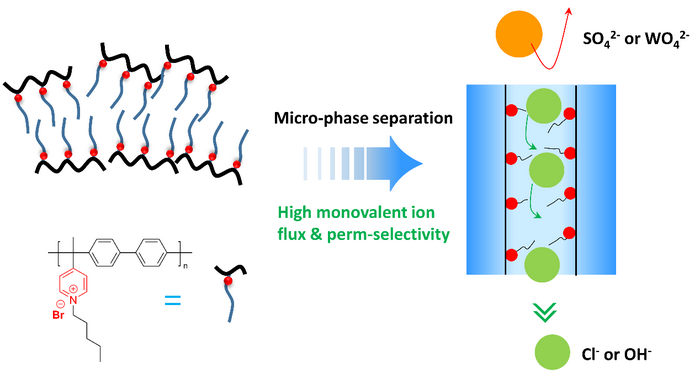Monovalent anion perm-selective membranes (MAPMs) combined with electrodialysis can simultaneously realize the efficient separation of mono-/di-valent anions and the concentration of monovalent salt. However, their applications in practical industrial scenarios are limited due to the low anion selectivity of commercial MAPMs, especially the poor alkali stability. Recently, a team of scientists has constructed poly(alkyl-biphenyl pyridinium)-based anion exchange membranes with hydrophobic side chains that provide excellent permoselectivity to separate monovalent ions such as chloride (Cl−) and hydroxide (OH−) from other multivalent ions in electrodialysis. Their work is published in the journal Industrial Chemistry & Materials (ICM) on January 2023.

Credit: Tongwen Xu, University of Science and Technology of China
Monovalent anion perm-selective membranes (MAPMs) combined with electrodialysis can simultaneously realize the efficient separation of mono-/di-valent anions and the concentration of monovalent salt. However, their applications in practical industrial scenarios are limited due to the low anion selectivity of commercial MAPMs, especially the poor alkali stability. Recently, a team of scientists has constructed poly(alkyl-biphenyl pyridinium)-based anion exchange membranes with hydrophobic side chains that provide excellent permoselectivity to separate monovalent ions such as chloride (Cl−) and hydroxide (OH−) from other multivalent ions in electrodialysis. Their work is published in the journal Industrial Chemistry & Materials (ICM) on January 2023.
Monovalent ion perm-selective membranes can achieve precise ion separation, which has important needs in various fields such as lithium extraction from salt lakes, brine refining, and zero discharge of high-salt wastewater. As for the MAPMs, the biggest challenges are the low anion selectivity and the poor alkali resistance. “The selective separation of mono-/di-valent anions involves the recycling of high salt wastewater, the purification of brine in chlor-alkali industry, and the recovery of waste alkali. How to construct MAPMs with high anion selectivity and high alkali stability is the direction of our team’s efforts,” explains Tongwen xu, a professor at the University of Science and Technology of China.
Anion exchange membranes (AEMs) are usually fabricated by bromo- or chloromethylation of polymers and then quaternization via a Menshutkin reaction. However, this method needs highly toxic chemicals such as chloromethylation or bromination reagents that may risk the environment. The ionic conductivity and alkaline stability of such membranes are often low because the main chain’s cationic head groups have low mobility; can barely undergo a good microphase separation to create efficient channels for OH− ion conduction. In addition, benzyl groups, which commonly exist in the primary chain AEMs, are quickly attacked by the OH− ions and encounter nucleophilic substitution reactions. Higher ion exchange capacity is advantageous for OH− transportation but may increase water uptake. The AEMs may swell severely, lowering the separation efficiency, and exacerbating the attack of OH− on the membranes, thus damaging their chemical and mechanical robustness.
The researchers offered a chemically robust polymer backbone with a more elongated side chain group to overwhelm the above-mentioned problems in the traditional AEMs. In the resulting MAPMs, the microphase separation appears between long-side chains and a hydrophobic polymer. This is equivalent to building a selective anion transport channel in the membrane, which is favorable to the active transport of Cl− compared with SO42− ion giving a high permoselectivity. It also showed a high OH− flux with a high permoselectivity between OH−/WO42−, much higher than the commercial Neosepta ACS membrane. Especially, based on the design of an ether-bond-free polymer backbone, the MAPMs also showed excellent alkali stability after twenty runs.
“We also found that these novel MAPMs with significant microphase separation morphology can separate bromide, fluoride, and nitrate ions from other multivalent anions based on the differences in hydration radius and Gibbs hydration energy with high selectivity,” said Xu.
The researchers also revealed that they have completed a pilot-scale preparation of the MAPMs. The comprehensive evaluation of the performance of the pilot-scale MAPMs is still in progress. They plan to commercialize the MAPMs at their earliest to solve some of the industry’s difficulties in the anion separation.
The research team includes Hongxin Yang, Noor Ul Afsar, Xiaolin Ge, Xingya Li, Liang Ge*, and Tongwen Xu* from the University of Science and Technology of China (USTC).
This research is funded by the National Key Research and Development Program of China, the National Natural Science Foundation of China, the Anhui Provincial Key Research and Development Plan, and the Natural Science Foundation of Anhui Province.
Industrial Chemistry & Materials is a peer-reviewed interdisciplinary academic journal published by Royal Society of Chemistry (RSC) with APCs currently waived. Icm publishes significant innovative research and major technological breakthroughs in all aspects of industrial chemistry and materials, especially the important innovation of the low-carbon chemical industry, energy, and functional materials.
Journal
Industrial Chemistry and Materials
DOI
10.1039/D2IM00043A
Method of Research
Experimental study
Subject of Research
Not applicable
Article Title
Poly(alkyl-biphenyl pyridinium) anion exchange membranes with a hydrophobic side chain for mono-/divalent anion separation
Article Publication Date
4-Jan-2023




